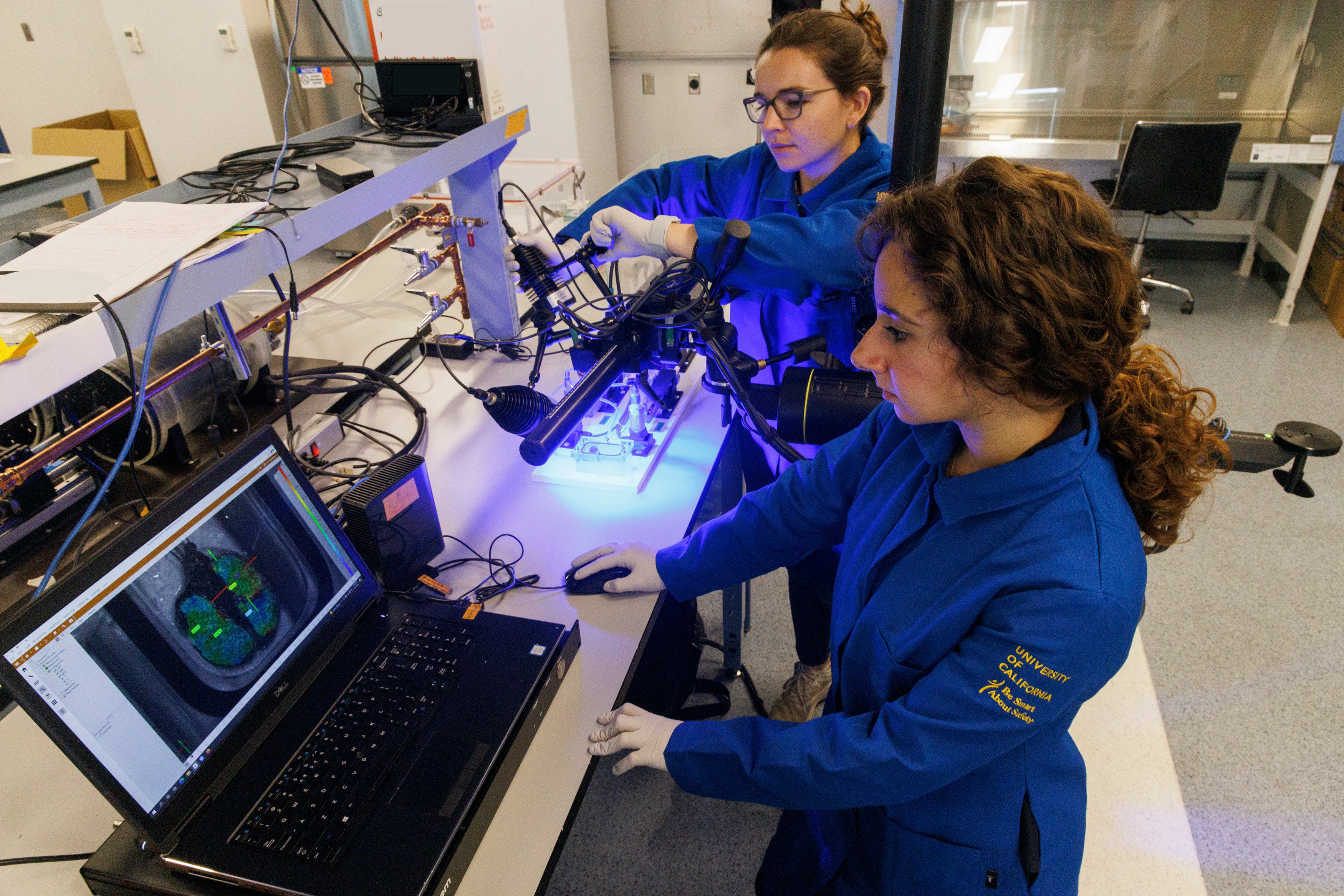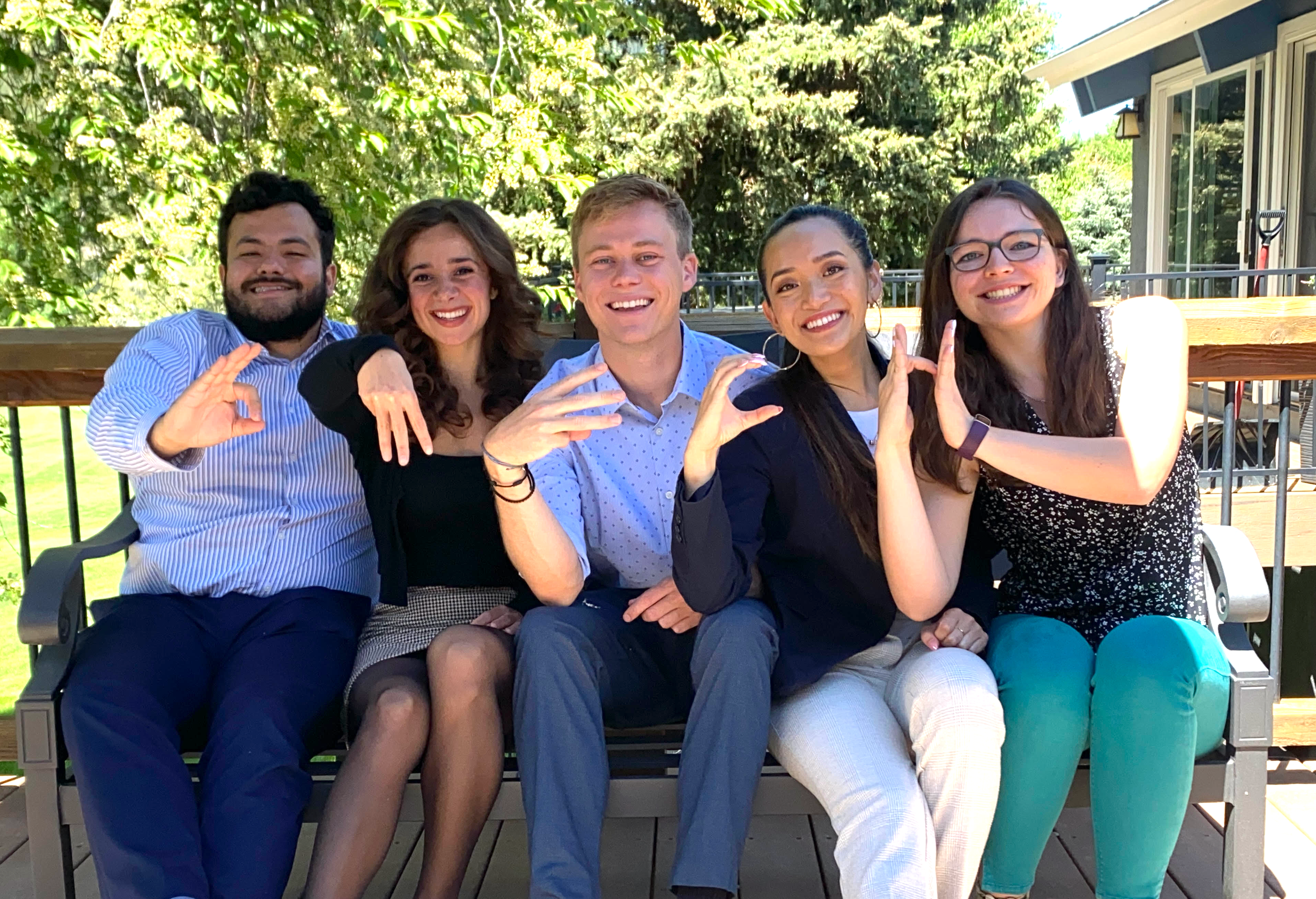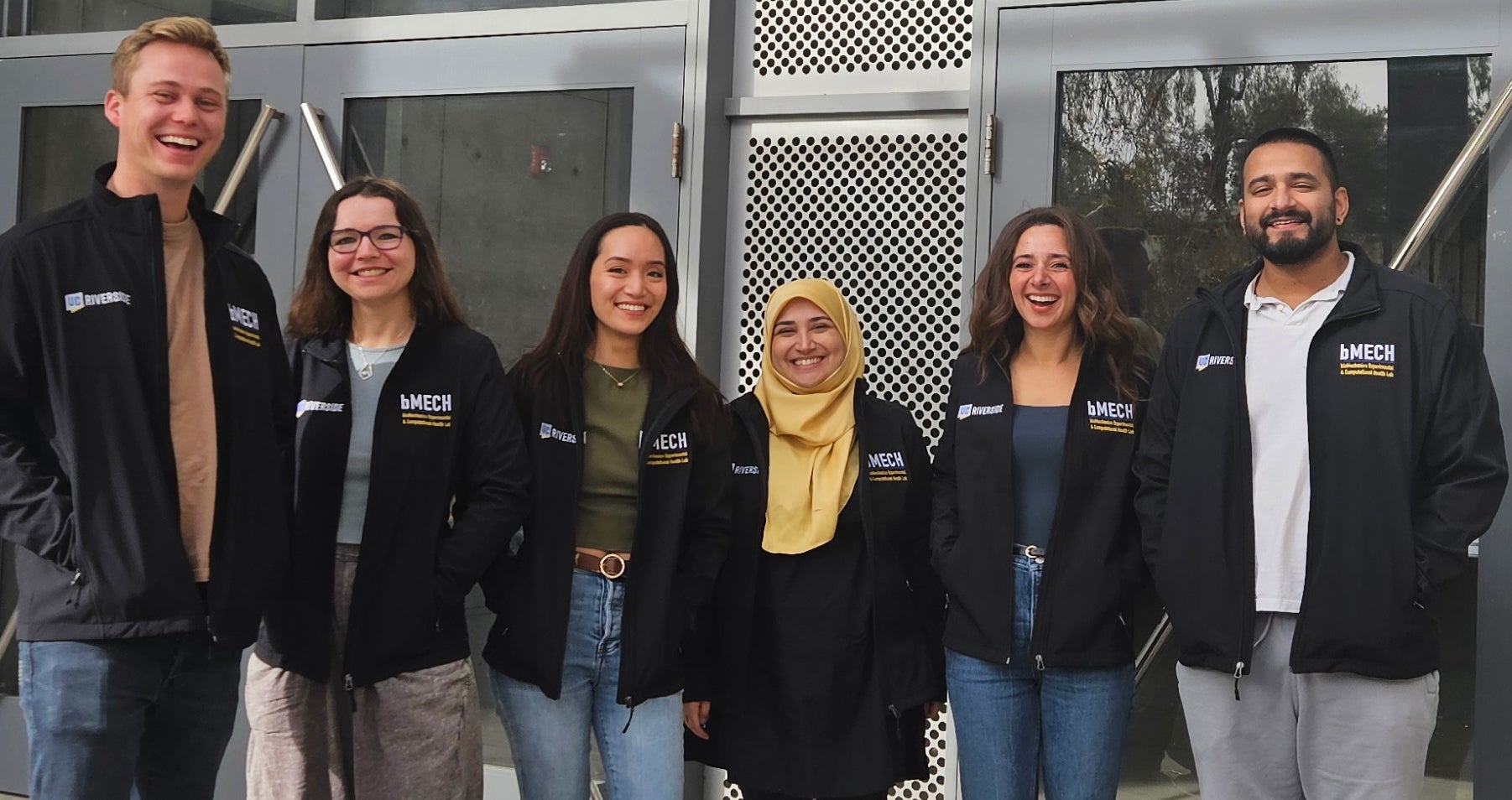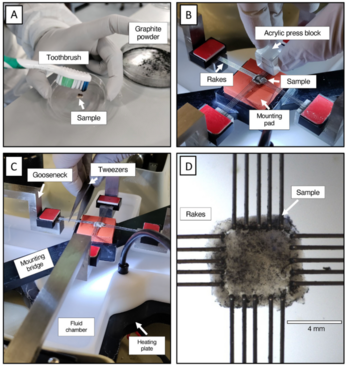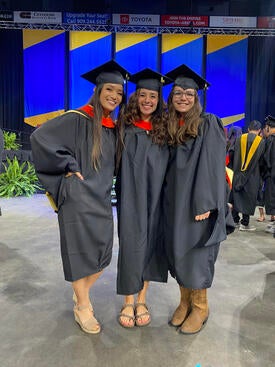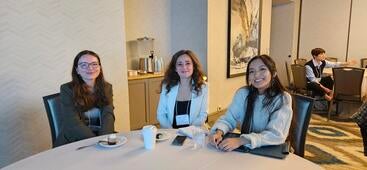About
Our research was named one of the Major Scientific Breakthroughs of
the University of California 10-Campus System, the only UCR Honoree
COVID-19: We are developing novel diagnostics and methods to mitigate the negative impact of the pandemic based on the fundamental pulmonary tissue biomechanics research conducted in our lab.
Welcome to bMECH
The bMECH lab leverages engineering fundamentals and technological advancements for medical impact. Led by Professor Mona Eskandari, Ph.D., our area of expertise centers on the structural and material characterization of the lung at the organ-, tissue-, and micro-scale. We pioneer experimental techniques, such as interfacing our novel breathing mimicry platforms with digital image correlation methods to enable unprecedented quantification capabilities for examining rapid and finite breathing mechanics, and develop predictive computational biophysics-based tools to inaugurate innovative diagnostic techniques for medical intervention. We focus on investigating multiscale pulmonary function through an engineering lens, seeking solutions to scientific questions surrounding lung disease.
Our research is supported by
News
Prof. Eskandari was invited to present bMECH's pioneering methods and recent breakthroughs at Caltech (The California Institute of Technology) Mechanical and Civil Engineering Seminar Series.
Congratulations to Matt first first-author publication in bMECH! "Lung recruitment mechanics: coalescing tissue strains with organ expansion" in Respiratory Research (Impact Factor 4.7). In this study, we find evidence of greater regional strains and inhomogeneity linked to overdistension and stress raisers in sustained inflation maneuvers compared to escalation maneuvers by inaugurating the first continuous quantification and association of local-to-global maneuver mechanics.
Prof. Eskandari was invited to Edwards Lifesciences as part of the External Seminar Speakers Series to share bMECH's exclusive methods of linking organ deformations and tissue strains.
Prof. Eskandari was invited to Brown University as part of the I-BEAM Biomedical Engineering Seminar Series (Institute for Biology, Engineering, and Medicine) to share the new insights on lung biomechanics.
Congratulations to Katie for her manuscript published in American Journal of Physiology: Lung Cellular and Molecular Physiology (Impact Factor 3.6), titled "Fibrotic and emphysematous murine lung mechanics under negative-pressure ventilation." Our nuanced conclusions indicate the detection capabilities of multiple mechanics-based biomarkers are sensitive to the ventilation mode, where NPV exhibits more altered mechanics metrics in PPE-exposed and HDE-exposed groups compared with PPV counterparts, suggesting the resolution of biomarkers when applied under NPV research considerations may offer greater versatility.
Prof. Eskandari was an invited to share bMECH's research at the National Science Foundation (NSF) Advanced Technologies for the Preservation of Biological Systems (ATP-Bio), an Engineering Research Center (ERC) between the University of Minnesota, Massachusetts General Hospital, Texas A&M, UC-Riverside, UC-Berkeley, and Carnegie Mellon.
Congratulations to Dr. Arif Badrou on his publication in bMECH: "Towards Constructing a Generalized Structural 3D Breathing Human Lung Model Based on Experimental Volumes, Pressures, and Strains." In this invited manuscript published in PLOS Computational Biology, we construct the first continuously ventilated three-dimensional structurally representative pulmonary model informed by both organ- and tissue-level breathing experiments from a cadaveric human lung.
Prof. Eskandari was honored with the Junior Excellence in Teaching Award as the only College of Engineering recipient. This prestigious accolade is reserved for faculty whose career record demonstrates commitment and determination of an outstanding teacher while pursuing research excellence. The Celebration of Teaching event featured a video interview and article and feature.
Congratulations to bMECH! In this invited manuscript, co-authored by each member of the bMECH lab, we describe the latest techniques for experimental characterization and computational modeling, representing dissemination of major efforts to advance the field of lung biomechanics. Find it at Current Protocols, Special Biomechanics Issue
Congratulations to Gustavo for his first manuscript published in Acta Biomaterialia (Impact Factor 9.7)! Pulmonary air leaks are amongst the most common complications in lung surgery and adhesives are commonly tested on pig and rat lungs, but applied to human lungs. We characterize the mechanical properties of the visceral pleura, the surface layer of the lung, of human lungs for the first time, and compare its performance to animal surrogates.
Dr. Badrou presented advances in structural breathing computational simulations of the human lungs at the World Congress on Computational Mechanics 2024 in Vancouver Canada. Congratulations!
Prof. Eskandari was invited to chair the Respiratory Biomechanics Session at the 29th Congress of the European Society for Biomechanics.
Congratulations to Talyah on publishing the biaxial material properties of healthy versus diseased lungs in mice in Results in Engineering (Impact Factor 5). We contrast fibrotic and emphysematous lung tissues and demonstrate anisotropic, stiffness, strain-rate, and age effects.
Prof. Eskandari was invited to chair the panel session "Respiratory Medicine in the Silicon Era" at the American Thoracic Society (ATS 2024) in San Diego.
Congratulations to Matt for winning the Best PhD Research Award at the Summer of Biomechanics, Bioengineering, Biotransport's (SB3C) 2023 Conference (American Society of Mechanical Engineering - Bioengineering Division) for his work on lung surfactant!
Crystal received the Diversity Travel Award and her research on human airways was accepted as a podium presentation at SB3C 2024. Congratulations!
Gustavo was named a Best PhD Research Finalist at SB3C 2024 for his research on the lung's visceral pleura. Congratulations!
Talyah's abstract contrasting positive versus negative pressure on COPD-induced mouse lungs was accepted as a podium presentation at SB3C 2024. Congratulations!
Katie presented her latest research findings on spherical indentation of lung tissue at SB3C 2024. Congratulations!
Dr. Badrou presented his latest research findings on developing a structural breathing model of the human lung at SB3C 2024. Congratulations!
Congrats to our undergraduate researcher alumni for co-authoring this study! bMECH's latest manuscript, a collaboration with Drs. Stanislav Polzer at the VSB- Technical University of Ostrava, Tara Nordgren at Colorado State University, and David Carter at UCR's Microscopy and Imaging Core Facility, was published in the #1 ranked journal for microscopy, Microscopy and Microanalysis We provide an automatic algorithm to simultaneously estimate fiber global orientation, abundance, and waviness in an investigated image, which is central for accurate characterization of soft tissue microstructures and the modeling of their mechanical response particularly in compromised pathological states.
bMECH lab's research was featured as one of the 12 incredible research breakthroughs across the 10-campus University of California-wide system! The research demonstrates the mechanical differences between how we naturally breathe and how artificial ventilators make us breathe, published in the prestigious American Journal of Respiratory and Critical Care Medicine (Impact Factor 30.5)
Congratulations to Katie for publishing her insightful investigation in the Annals of Biomedical Engineering. We find that past contradictory and controversial findings in the field regarding ventilation mode comparisons between positive and negative pressure ventilation may be linked to the chosen animal model.
Congratulations on earning your Master's degrees, Crystal, Talyah, and Katie!
Prof. Eskandari's second invited Letter to the Editor for publication in the American Journal of Respiratory and Critical Care Medicine, co-authored by Prof. Jason Bates, provides a mechanics- and physics-based understanding of how artificial ventilation and physiological breathing differ.
Prof. Eskandari was invited to present bMECH's research breakthroughs at the highly exclusive and historical 18th Flow-Volume Underworld meeting in Sestri Levante, Italy.
Matt's research was accepted for a podium presentation (as a first year graduate student!) at Summer of Biomechanics, Bioengineering, Biotransport's (SB3C) 2023 Conference (American Society of Mechanical Engineering - Bioengineering Division). Congratulations!
Talyah's research on the material tensile properties of healthy versus diseased lung tissue was presented at SB3C. Congratulations!
Crystal's latest research findings on the local strains of intact airways was accepted for a podium presentation at SB3C. Congratulations!
Congratulations! Gustavo presented his research at SB3C 2023 (as a first year graduate student!)
Katie's research diseased state lung mechanics under negative pressure ventilation was presented at SB3C. Congratulations!
In recognition of her advocacy, Prof. Eskandari was invited to serve as the Chair for Diversity, Equity, and Inclusion as an organizing member of the SB3C 2023 conference.
Congratulations to Crystal on publishing the first mechanical characterization of fiber degeneration effects in pulmonary airways! Respiratory Research (Impact Factor 7.1). Lung diseases are often characterized by irreversible damage to connective tissue elastin and collagen fiber networks. Exploring the mechanical behavioral changes after enzymatic treatments provides us with an improved understanding of disease manifestation and the individual fiber roles for the first time for airway tissues.
Congratulations to Katie, Talyah, and Crystal for winning SB3C conference travel grants!
The bMECH lab applies for the patent "Apparatus and Methods for Pulmonary Monitoring," in Europe, Canada, Australia, China, India, Japan, Brazil, and U.S.
Congratulations to Talyah on publishing the mechanics of diseased lungs using local DIC characterization for the first time! Nature Scientific Reports (Impact Factor 5). We were demonstrate how fibrotic lungs may be particularly susceptible to damage when contrasted to the strain patterns of healthy counterparts, helping to advance understanding of how ventilator induced lung injury develops.
Prof. Eskandari's invited Letter to the Editor was published in the American Journal of Respiratory and Critical Care Medicine theorizing that the fundamental mechanical differences observed between artificial ventilation and physiological breathing can be explained using the thick-walled derivation of the Lamé equations.
Congratulations to Katie and Samaneh for receiving the Graduate Research Mentorship Program and Dissertation Year Program Fellowships !
Congratulations to joint first co-authors Samaneh and Crystal on publishing recent groundbreaking scientific findings in the prestigious American Journal of Respiratory and Critical Care Medicine (Impact Factor 30.5). In order to mitigate ventilator injury, we address a long-standing debate in the pulmonary medical community: do ventilator breathing mechanics mimic that of natural breathing? Using an innovative multi-apparatus interface developed in our lab, we minimized confounding factors by subjecting the same lung specimen to both loading modes. We found exclusive evidence that both global and local energetics, stretches, and distortions are reduced in physiological breathing compared to artificial ventilation. This also holds implications for the COVID-19 Pandemic. News Feature
Congratulations to Samaneh on her publication in Acta Biomaterialia (Impact Factor 10.6), titled "Biaxial mechanical properties of the bronchial tree: Characterization of elasticity, extensibility, and energetics, including the effect of strain rate and preconditioning."
Congratulations to Talyah on her first manuscript, coauthored by Katie, Samaneh, and Crystal in Physiological Reports titled "Associating local strains to global pressure–volume mouse lung mechanics using digital image correlation ." By quantifying strain evolutionary behavior in relation to pressure–volume measures, we associate time-continuous local to global mouse lung mechanics for the first time and further examine the role of volume and rate dependency. Research was conducted in collaboration with the Nordgren Lab (Colorado State University)
The non-confidential disclosure of our new device for pulmonary function testing in the 21st century (also published as a PCT patent application) is now available through the Office of Technologies Partnerships at UCR. This new medical device holds promise to be fast, easy and accurate for a patient to self-administer while providing greater insight for lung health than spirometry.
Congratulations Talyah and Crystal for being named National Science Foundation Graduate Research Fellows! The prestigious NSF-GRFP award is offered to only a select group of graduate students in the nation, based on the merit of their research and potential for scientific impact
Congratulations Gustavo for being awarded the Eugene Cota-Robles Fellowship! This award is named in honor of one of the earliest Mexican-American professors in the University of California system and is intended to supports students with demonstrated high potential and promise for an academic career
Prof. Eskandari's invited commentary was published in the Journal of Applied Physiology, titled "Commentaries on Viewpoint: Small airways vs. large airways in asthma: time for a new perspective."
Congrats to Katie for receiving the NASA California Space Grant Consortium (CaSGC) Fellowship!
Congratulations to Katie on her first manuscript, coauthored by Talyah, Samaneh and Crystal in Nature Scientific Reports ! Mice are widely used in the study of lung pathologies, but there is a lack of fundamental mechanical measurements. Here we establish a baseline from which to assess diseased murine mechanics in the future. Research was conducted in collaboration with the Nordgren Lab (Colorado State University)
Congrats Samaneh for being named a 2022 Best PhD Research Finalist at the ASME SB3C annual conference!
Congratulations Crystal, Samaneh, Katie, and Talyah on their article in Respiratory Research "Examining lung mechanical strains as influenced by breathing volumes and rates using experimental digital image correlation." In the age of COVID-19, the insights provided by the real-time continuous measures, and the kinetics to kinematics pulmonary linkage established by this experimental study offers valuable characterizations for computational models and establishes a framework for future studies to compare healthy and diseased lung mechanics to further consider alternatives for effective ventilation strategies.
Congrats! Crystal, Katie, and Talyah received the ASME SB3C travel grant award to attend the 2022 annual conference in Maryland!
Congrats to Katie for receiving the World Congress for Biomechanics travel grant award to attend the quadrennial international conference in Taiwan!
Congrats Samaneh for receiving the Graduate Research Mentorship Fellowship !
Prof. Eskandari received the prestigious Hellman Foundation Fellowship awarded to promising faculty who exhibit potential for great distinction in their area of expertise.
The bMECH lab was awarded a proof-of-concept grant to develop a lung diagnostics minimal viable product through the NSF UCR I-Corps INNOVA'R program
Congrats! Mohammad, Crystal and Samaneh's article "Developing a Lung Model in the Age of COVID-19: A Digital Image Correlation and Inverse Finite Analysis Framework" has been published as part of a Special Issue in Frontiers in Biomechanics: Multiscale Modeling to Tackle the Complexity of Load-Bearing Organ and Tissue Regulation. The proof-of-concept computational framework established here can be readily applied to investigate the impact of assorted organ-level ventilation strategies on local pulmonary force and strain distributions, and to further explore how diseased states may alter the load-bearing material behavior of the lung.
Prof. Eskandari has been conferred the permanent title of Distinguished Teaching Professor and will be inducted into UCR's Academy of Distinguished Teaching.
The bMECH lab was awarded a grant through Eurosemillas Technology Acceleration Program and the Office of Technology Partnerships to develop lung diagnostics
Prof. Eskandari received the Best Junior Faculty Presentation Award from the 16th U.S. National Congress on Computational Mechanics and Springer Journals.
Congratulations Crystal for winning 2nd Place for Best PhD Research at the ASME SB3C annual conference!
The bMECH lab files an international patent "Apparatus and Methods for Pulmonary Monitoring," now pending
Congrats! Mohammad and Samaneh's invited review "Mechanical Behavior of the Airway Wall in Respiratory Disease" (open access) has been published. The mechanical behavior of the airway wall corresponding to structural remodeling alterations are categorized at the tissue and microstructural levels, critically revisited through recent works from the past three years, and contextualized within the broader literature.
Congrats Talyah, Samaneh, and Crystal for being named Best PhD Research Finalists, and to Crystal for being selected as a Finalist for the Research Cover Art Contest at the ASME SB3C annual conference!
Prof. Eskandari co-chaired the "understanding lung function and disease through mathematical modeling and experiment" minisymposium at the Society of Mathematical Biology Conference.
Congrats Samaneh for receiving the Graduate Research Mentorship Fellowship and the Lung-Wen Tsai Best Research Design Award!
Prof. Eskandari co-chaired the "quantification and modeling of spatially heterogeneous phenomena in biological materials" minisymposium at the 16th US National Congress for Computational Mechanics.
Congrats Talha for being awarded the National Goldwater Scholarship!
The bMECH lab was awarded an extramural grant for a lung structural biomechanics research project to improve ventilation strategies for pulmonary patients.
Congrats Katie, Talyah, and Crystal for receiving travel grants from the annual MEGSA Symposium!
The Entrepreneura Summit has invited Prof. Eskandari to be a speaker and moderator at the Possibilities for Women in STEM session
Prof. Eskandari was an invited speaker at Northern Arizona State University Mechanical Engineering departmental seminar series
Prof. Eskandari was invited as a plenary speaker to the International Living Heart and Virtual Twin for Humans Dassault Systèmes Symposium
Congrats! Crystal, Samaneh, and Mohammad's manuscript, titled "Novel Mechanical Strain Characterization of Ventilated Ex Vivo Porcine and Murine Lung Using Digital Image Correlation" has been published in Frontiers in Respiratory Physiology - (open access). We have established the foundation for linking local strains to global mechanics in the breathing lung, characterizing the regional response of the lung across various species, and contrasting healthy and pathological states. Thanks to our sponsors and our collaborators.
Prof. Eskandari was invited to present at the Beckman Research Institute at City of Hope's Department of Computational and Quantitative Medicine monthly seminar series
Professors Mona Eskandari, Mariam Salloum, and Annika Speer were awarded an extramural grant to redesign engineering curricula centered on improving technical communication skills.
Prof. Eskandari was invited to share research findings at Univ. of California at Irvine's Department of Biomedical Engineering Seminar Series
Congrats! Samaneh, Crystal, and Swathi's manuscript, titled "Introducing a Custom-Designed Volume-Pressure Machine for Novel Measurements of Whole Lung Organ Viscoelasticity and Direct Comparisons Between Positive- and Negative-Pressure Ventilation" has been published in Frontiers in Bioengineering and Biotechnology - Biomechanics (open access). We have conceptualized and designed a novel system to measure the volume and pressure response of lungs, surpassing the capabilities of traditional machines and constructed to range mouse, pig, and human lung size-scales. Thanks to our collaborators, the Nordgren lab at UCR's School of Medicine and CellScale Biomaterials Testing
The Dean's Biomed Collaborative Grant from the School of Medicine was awarded to the bMECH lab to explore new techniques for diagnosing pulmonary disease.
Prof. Eskandari received the 2020 Distinguished Teaching Award
The UC National Laboratory Fees Research Grant was awarded to the bMECH lab. The initiative is aimed at rapidly supporting emergent research in areas
related to COVID-19.
Prof. Eskandari was awarded a plaque from UCR's University Honors Program for 2020 Faculty Mentor of the Year.
UCR Academic Senate awarded a Regent's Faculty Fellowship to Prof. Eskandari.
Our lab's lung mechanics research is supporting the fight against coronavirus as featured on UCR News: #COVID-19 highlights what we have yet to learn about lung mechanics
Samaneh's manuscript, titled "Characterizing the viscoelasticity of extra- and intra-parenchymal lung bronchi" has been published in the Journal of the Mechanical Behavior of Biomedical Materials (open access). This is the first study to investigate proximal and distal bronchial energy efficiency and contextualize tissue biochemical composition using rheological models. Results establish a foundation for future considerations of the role of viscoelasticity in diseased states. Congrats Samaneh!
Samaneh presented her research on the viscoelasticity of the bronchial network at the Inaugural Southern California Mechanics Workshop at UC San Diego.
Prof. Eskandari was invited to NSF's Computational Mechanics Vision Workshop at the University of Michigan.
Talha won a Presentation Award in the area of Engineering, Math, and Physics in addition to a travel grant to present his work on fiber imaging morphology at the 2019 Annual Biomedical Research Conference for Minority Students. Congrats Talha!
Latest research findings featured on UCR News: Crimped or Straight? Lung fiber shape influences elasticity: The shape and architecture of collagen and elastin fibers can improve our understanding of lung diseases, including the one associated with vaping
Ricardo and Talha presented their research on imaging bronchial tissues at the MSRIP Research Symposia at UC-Riverside and UC-San Diego
Prof. Eskandari was an Invited Speaker at the 16th International Symposium on Computer Methods in Biomechanics and Biomedical Engineering and the 4th Conference on Imaging and Visualization (CMBBE) at Columbia University, New York
bMECH's latest research findings published in Acta Biomaterialia is now available online. The link between structure and function is explored through constitutive modeling, biochemistry and histology
Our lab's research, featured on UCR News! UC Riverside research could eventually lead to advances in pulmonary healthcare: Scientists are just beginning to understand the mechanics of the lung
Samaneh received a travel grant to present her work on pulmonary viscoelasticity at the Summer of Biomechanics Biotransport and Bioengineering Conference (SB3C) in Seven Spring Pennsylvania. Congrats Samaneh!
The bMECH lab and collaborators were awarded First Place in the category of Best Research Paper from the American Society of Engineering Education: "Provoked Emotion in Student Stories of Motivation Reveal Gendered Perceptions of What It Means to be Innovative in Engineering"
The Molecular and Translational Medicine Grant was awarded to the bMECH lab. The initiative, from the School of Medicine and Entrepreneurial Proof-of-Concept and Innovation Center at the University of California at Riverside, is aimed at catalyzing translational life-science research to improve the health of individuals by translating basic findings into future innovative diagnostics or therapeutics
Prof. Eskandari was recognized by the International Journal for Numerical Methods in Biomedical Engineering with the Best PhD Award
Prof. Eskandari received the honor of being named the Flag Bearer for Stanford University's School of Engineering

